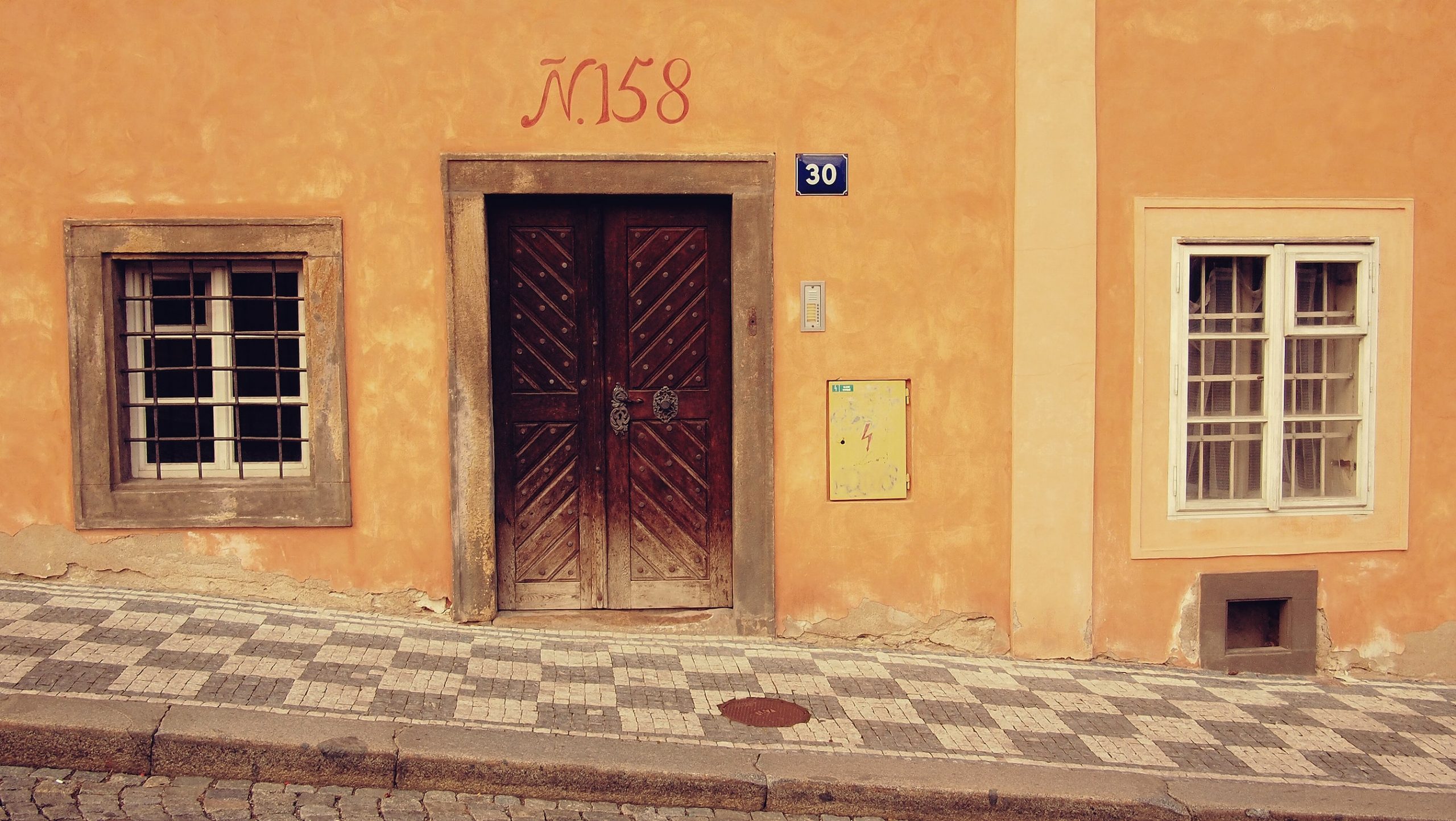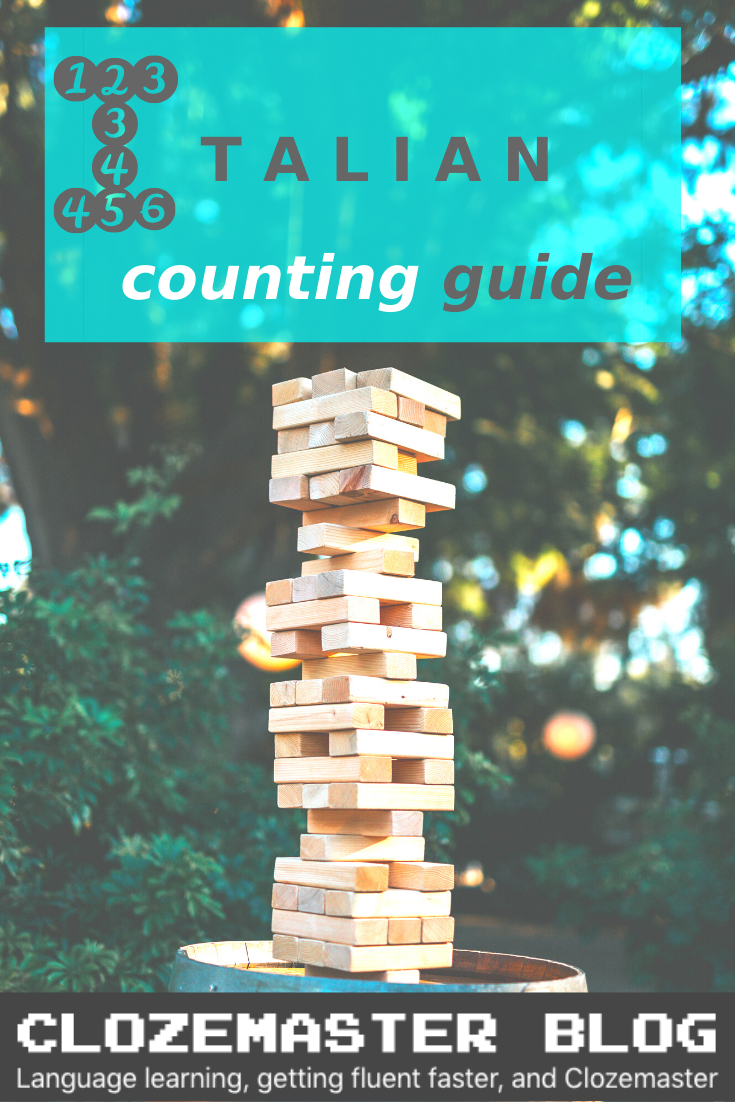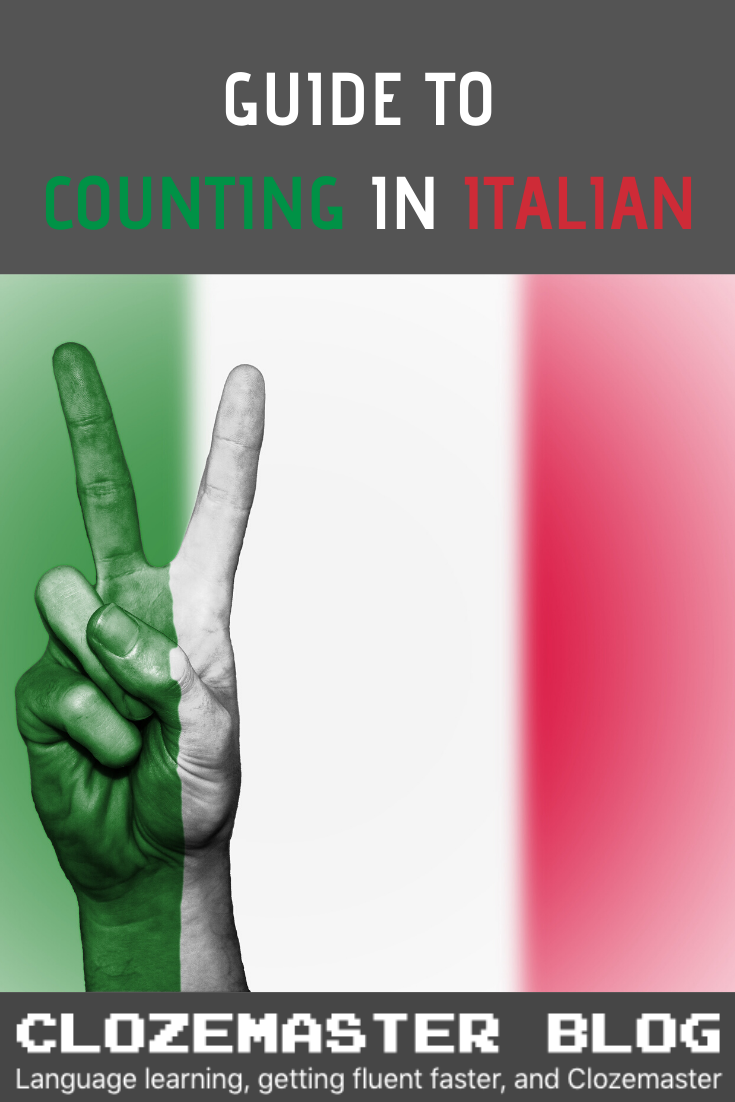
If you’re learning a foreign language knowing the numbers is essential to go shopping, tell people about your telephone number, your birthday, or to talk about the date. Italian numbers are pretty easy to remember and follow a simple and predictable pattern. Let’s start with the basics and by the end of this article you’ll be able to use and construct Italian numbers to one billion and up!
Italian numbers 1-10
Let’s see first how to count from one to ten. It’s not that difficult to remember these Italian numbers as some of them resemble the English ones.
| Italian numbers | English numbers |
| zero | zero |
| uno | one |
| due | two |
| tre | three |
| quattro | four |
| cinque | five |
| sei | six |
| sette | seven |
| otto | eight |
| nove | nine |
| dieci | ten |
Italian cardinal numbers never change according to the gender and number of the name they refer to. The only exception is uno, the number one. So, if referring to a feminine name, you will use the feminine suffix -a and say una instead:
Ho comprato una rosa.
I bought one rose.
Lucia ha tre figli e una figlia.
Lucia has three sons and one daughter.
Sometimes the feminine “una” drops the final -a and is shortened in un’, when the following feminine name begins with a vowel. Remember that this only happens with feminine nouns.
Ho solo un’arancia in frigo.
I’ve only got one orange in the fridge.
Italian numbers 11-20
After twenty, Italian numbers are pretty straightforward and are easy to form and remember. However, you need to learn the numbers from 1 to 19 by heart. After ten, the numbers keep a part of the root in some cases. For instance, undici (eleven) is similar to uno (one), and tredici (thirteen) is similar to tre (three) Let’s see how to count from 11 to 20:
| Italian numbers | English numbers |
| undici | eleven |
| dodici | twelve |
| tredici | thirteen |
| quattordici | fourteen |
| quindici | fifteen |
| sedici | sixteen |
| diciassette | seventeen |
| diciotto | eighteen |
| diciannove | nineteen |
| venti | twenty |
Oggi è il quattordici Aprile.
Today is the 14th of April.
Marco ha diciannove anni.
Marco is nineteen years old.
Cardinal numbers in Italian can be used to indicate a quantity or a price, to tell the date and the time. Instead of saying 5 PM, Italians may use the number 17. For instance:
Che ore sono? Sono le diciassette.
What time is it? It’s 5pm (seventeen).
Abbiamo appuntamento alle quindici e trenta.
We have an appointment at 3.30pm (fifteen thirty).
Italian numbers 21-100
Once you know how to count to twenty, you can build all the other numbers by using the base number, for instance venti (20), and adding any number from one to ten to create ventuno (21), ventidue (22), ventitré (23) and so on.
| Italian numbers | English numbers |
| venti | twenty |
| ventuno | twenty-one |
| ventidue | twenty-two |
| ventitré | twenty-three |
| ventiquattro | twenty-four |
| venticinque | twenty-five |
| ventisei | twenty-six |
| ventisette | twenty-seven |
| ventotto | twenty-eight |
| ventinove | twenty-nine |
| trenta | thirty |
You can see how after twenty you just need to use the root of the number and then add uno (1), due (2), tre (3), quattro (4), etc. Remember that the numbers venti (20), trenta (30), quaranta (40), cinquanta (50), sessanta (60) and so on always drop the final vowel when combined with uno (1) and otto (8). For instance:
- venti (20): ventuno (21), ventotto (28)
- trenta (30): trentuno (31), trentotto (38)
- quaranta (40): quarantuno (41), quarantotto (48)
- cinquanta (50): cinquantuno (51), cinquantotto (58)
- sessanta (60): sessantuno (61), sessantotto (68)
- settanta (70): settantuno (71), settantotto (78)
- ottanta (80): ottantuno (81), ottantotto (88)
- novanta (90): novantuno (91), novantotto (98)
Tre (3) is written without an accent, but when it’s the smaller digit of numbers such as ventitré (23), trentatré (33) quarantatré (43) and so on it is written with an acute accent.
| 30 – trenta | 40 – quaranta | 50 – cinquanta |
| 31 – trentuno | 41 – quarantuno | 51 – cinquantuno |
| 32 – trentadue | 42 – quarantadue | 52 – cinquantadue |
| 33 – trentatré | 43 – quarantatré | 53 – cinquantatré |
| 34 – trentaquattro | 44 – quarantaquattro | 54 – cinquantaquattro |
| 35 – trentacinque | 45 – quarantacinque | 55 – cinquantacinque |
| 36 – trentasei | 46 – quarantasei | 56 – cinquantasei |
| 37 – trentasette | 47 – quarantasette | 57 – cinquantasette |
| 38 – trentotto | 48 – quarantotto | 58 – cinquantotto |
| 39 – trentanove | 49 – quarantanove | 59 – cinquantanove |
| 60 – sessanta | 70 – settanta | 80 – ottanta | 90 – novanta |
| 61 – sessantuno | 71 – settantuno | 81 – ottantuno | 91 – novantuno |
| 62 – sessantadue | 72 – settantadue | 82 – ottantadue | 92 – novantadue |
| 63 – sessantatré | 73 – settantatré | 83 – ottantatré | 93 – novantatré |
| 64 – sessantaquattro | 74 – settantaquattro | 84 – ottantaquattro | 94 – novantaquattro |
| 65 – sessantacinque | 75 – settantacinque | 85 – ottantacinque | 95 – novantacinque |
| 66 – sessantasei | 76 – settantasei | 86 – ottantasei | 96 – novantasei |
| 67 – sessantasette | 77 – settantasette | 87 – ottantasette | 97 – novantasette |
| 68 – sessantotto | 78 – settantotto | 88 – ottantotto | 98 – novantotto |
| 69 – sessantanove | 79 – settantanove | 89 – ottantanove | 99 – novantanove |
In Italy, you can sometimes hear people using random numbers – for instance ottantadue (82) or sessantotto (68) – to refer to the correspondent year and talk about past events.
Sono nato nell’82.
I was born in 1982.
Il ’68 fu un anno di cambiamenti sociali e politici.
1968 was a year of political and social changes.
Italian numbers 100 – 1 billion
Now that you know how to count from one to 99 in Italian, let’s see how to count from 100 and up. Learning about numbers greater than one hundred is useful to talk about years or higher-priced items. One hundred is cento in Italian. The hundred numbers follow the same English pattern. You will use the smaller number and add hundred after it; for instance, to say 200, in Italian you will use due (2) + cento (100) = duecento (200).
| cento | 100 |
| centouno | 101 |
| centocinquanta | 150 |
| duecento | 200 |
| trecento | 300 |
| quattrocento | 400 |
| cinquecento | 500 |
| seicento | 600 |
| settecento | 700 |
| ottocento | 800 |
| novecento | 900 |
| mille | 1.000 |
| milleuno | 1.001 |
| milleduecento | 1.200 |
| duemila | 2.000 |
| cinquemila | 5.000 |
| diecimila | 10.000 |
| quindicimila | 15.000 |
| centomila | 100.000 |
| cinquecentomila | 500.000 |
| un milione | 1.000.000 |
| cinque milioni | 5.000.000 |
| un miliardo | 1.000.000.000 |
When constructing bigger numbers, Italian and English have some differences. For instance, there is no Italian equivalent of the English way of saying “eleven hundred” or “fifteen hundred”. Italians would instead say one thousand one hundred, “millecento” (1100) or one thousand five hundred, “millecinquecento” (1500).
Ho speso milletrecento euro per riparare la macchina.
I’ve spent 1.300 euros to fix the car.
Cento (100) has no plural. Cento numbers are formed by using the small digit number (1 to 9) and then adding hundred in the end, just like in English. For instance: cento (100), duecento (200), trecento (300), quattrocento (400), cinquecento (500), seicento (600), settecento (700), ottocento (800), novecento (900).
Ho speso trecento euro per quel vestito.
I paid 300 euros for that dress.
Questa casa fu costruita duecento anni fa.
This house was built two hundred years ago.
Unlike cento, which remains unchanged, mille (1000) has the plural form mila.
- mille 1000
- duemila 2000
- tremila 3000
- quattromila 4000
- cinquemila 5000
- seimila 6000
- settemila 7000
- ottomila 8000
- novemila 9000
Milione (million) and miliardo (billion) also have a plural form which is milioni and miliardi.
A Roma ci sono 3 milioni di abitanti.
In Rome, there are 3 million inhabitants.
Il governo ha speso molti miliardi di dollari.
The government has spent several billions of dollars.

Italian ordinal numbers
Italian ordinal numbers are used to put things “in order” and are the equivalent of the English “first, second, third”, and so on. After 10 they are very easy to form, so you just need to memorize the ordinal numbers from one to ten:
| Italian | English |
| primo | first |
| secondo | second |
| terzo | third |
| quarto | fourth |
| quinto | fifth |
| sesto | sixth |
| settimo | seventh |
| ottavo | eighth |
| nono | ninth |
| decimo | tenth |
Oggi ho il mio primo colloquio di lavoro.
Today I’m going to have my first job interview.
All Italian ordinal numbers change according to the gender and number. If they refer to a feminine name you need to add the feminine suffix -a, while if they refer to a plural name, you need to add the suffix -i for plural and masculine names, and the suffix -e for plural, feminine names.
Domani andrò a Milano per la terza volta.
Tomorrow I will go to Milan for the third time.
Lucia e Maria sono stata le quarte ad entrare.
Lucia and Maria were the fourth to enter.
Due terzi della popolazione sono soddisfatti dell’operato del governo.
Two thirds of the population are satisfied with the government actions.
Ho una vista di 10 decimi da tutti e due gli occhi.
I have 20-20 vision (10/10 in Italian) with both eyes.
After ten, ordinal numbers are simply formed by adding the suffix -esimo to the cardinal number. You will need to drop the last vowel of the number and simply add –esimo. For instance, to say “eleventh” in Italian, you will drop the final vowel in undici (11) and add –esimo: undic-esimo.
| Italian | English |
| undicesimo | eleventh |
| dodicesimo | twelfth |
| tredicesimo | thirteenth |
| quattordicesimo | fourteenth |
| quindicesimo | fifteenth |
| sedicesimo | sixteenth |
| diciassettesimo | seventeenth |
| diciottesimo | eighteenth |
| diciannovesimo | nineteenth |
| ventesimo | twentieth |
| cinquantesimo | fiftieth |
| centesimo | hundredth |
| millesimo | thousandth |
| milionesimo | millionth |
| miliardesimo | billionth |
Le tecnologie del ventesimo secolo hanno cambiato il nostro stile di vita.
The twentieth century technology has changed our lifestyle.
I risultati saranno pubblicati il cinquantesimo giorno dopo l’esame.
The results will be published the fiftieth day after the exam.
The only exception includes numbers ending in –tré. Those numbers will just drop their accent and remain unchanged when –esimo is added:
Papa Giovanni Ventritreesimo.
Pope John 23rd.
Sono il quarantatreesimo in fila alle poste.
I’m the 43 rd in the waiting line at the post office.
Summary
Learning numbers is an essential part of studying any language. Forming Italian numbers isn’t difficult, it just requires a little practice. Now you have everything you need to know to count to 1 billion and up, so next time you won’t be afraid to ask the price when you’re shopping or eating at a restaurant in Italy!
Challenge yourself with Clozemaster
Learning Italian numbers might seem daunting at first, but don’t worry, it comes naturally with practice.
Test your skills and see what you’ve learned from this article by playing a selection of sentences with Italian numbers.
Sign up here to save your progress and start getting fluent with thousands of Italian sentences at Clozemaster.
Clozemaster has been designed to help you learn the language in context by filling in the gaps in authentic sentences. With features such as Grammar Challenges, Cloze-Listening, and Cloze-Reading, the app will let you emphasize all the competencies necessary to become fluent in Italian.
Take your Italian to the next level. Click here to start practicing with real Italian sentences!


